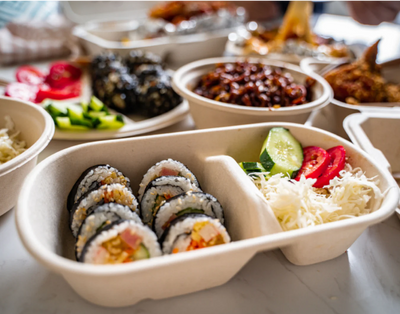Vi nhựa đang trở thành mối đe dọa trông có vẻ như nhỏ bé nhưng lại vô cùng nguy hiểm trong cuộc sống hàng ngày của chúng ta. Chúng xuất hiện ở khắp nơi, từ nguồn nước, chuỗi thức ăn và thậm chí là bên trong cơ thể con người. Nghiên cứu gần đây cho thấy hơn 80% người được kiểm tra có chứa vi nhựa, cho thấy sự xâm nhập sâu rộng của chúng. Điều này cho thấy nhiều hoạt động hàng ngày của chúng ta, bao gồm cả việc sử dụng bao bì thực phẩm, có thể góp phần vào sự tiếp xúc với vi nhựa.
Bao bì thực phẩm bằng nhựa, từng được ca ngợi vì sự tiện lợi, giờ đây đã trở thành mối lo ngại vì chúng có thể là nguồn gây ô nhiễm vi nhựa. Bài viết này sẽ khám phá mối liên kết giữa vi nhựa và bao bì thực phẩm và cách giảm thiểu sự tiếp xúc hiệu quả.
Bao Bì Thực Phẩm Hiện Nay
Chỉ cần vài phút rảo bước trong siêu thị, bạn sẽ bắt gặp nhiều loại bao bì thực phẩm làm từ các chất liệu khác nhau với các kích cỡ và kiểu dáng đa dạng. Tuy nhiên, không khó để nhận thấy nhựa chiếm ưu thế trên các kệ hàng.
Bao bì thực phẩm thường được chia thành hai loại: dùng một lần và tái sử dụng.
Chất Liệu Trong Bao Bì Nhựa Dùng Một Lần
Polyethylene (PE) và Polystyrene (PS): Được sử dụng phổ biến trong túi và bao bì thực phẩm dùng một lần. Mặc dù khá chắc chắn nhưng chúng dễ bị phân hủy thành vi nhựa.
Chất Liệu Trong Bao Bì Nhựa Có Thể Tái Sử Dụng
Polypropylene (PP): Được biết đến với độ bền và khả năng chịu nhiệt, PP thường được sử dụng trong các hộp thực phẩm có thể dùng trong lò vi sóng. Tuy nhiên, chúng vẫn có thể phân hủy thành vi nhựa theo thời gian, chỉ chậm hơn so với các loại nhựa khác.
Cách Bao Bì Thực Phẩm Giải Phóng Vi Nhựa

Vi nhựa có thể được giải phóng từ bao bì thực phẩm thông qua nhiều hành động hàng ngày mà chúng ta không để ý:
- Tiếp Xúc Với Nhiệt Độ: Sử dụng hộp nhựa trong lò vi sóng là một trong những cách nhanh nhất để chúng giải phóng vi nhựa. Nhiệt độ cao làm cho nhựa bị phân hủy, giải phóng các hạt nhỏ có thể làm ô nhiễm thực phẩm.
- Rửa Và Sử Dụng: Vết xước từ dao, nĩa hoặc sự mài mòn từ dụng cụ vệ sinh có thể làm vỡ cấu trúc bề mặt hộp và giải phóng vi nhựa.
- Phân Hủy Hóa Học: Thực phẩm chứa axit như giấm có thể đẩy nhanh quá trình phân hủy nhựa. Các yếu tố môi trường như tiếp xúc với ánh nắng cũng góp phần vào quá trình này.
- Sử Dụng Lâu Dài: Các hộp sử dụng lâu trên 6 tháng thường bị mòn và dễ giải phóng vi nhựa hơn.
Cách Giảm Thiểu Tiếp Xúc Với Vi Nhựa
Mặc dù vi nhựa hiện diện khắp nơi, nhưng có những cách hiệu quả để giảm thiểu sự tiếp xúc, đặc biệt là trong việc lưu trữ thực phẩm. Một điều chắc chắn là nếu chúng ta ít tiếp xúc với sản phẩm làm từ nhựa thì khả năng phơi nhiễm vi nhựa cũng sẽ giảm đi. Vậy hãy cùng nhau dần loại bỏ sản phẩm nhựa ra khỏi cuộc sống của chúng ta và thay thế chúng bằng những sản phẩm được làm từ các vật liệu bền vững và an toàn hơn.
Nếu bạn đang tìm kiếm các lựa chọn thay thế cho bao bì nhựa dùng một lần, dưới đây là một số gợi ý thân thiện với môi trường:
Bao Bì Thực Phẩm Bã Mía Có Thể Phân Hủy:

Làm từ sợi bã mía, những bao bì này bền, thoáng khí và thân thiện với môi trường. Chúng phân hủy thành dinh dưỡng cho đất thay vì vi nhựa, là lựa chọn bền vững tuyệt vời. EQUO cung cấp nhiều loại bao bì bã mía với các kích cỡ và kiểu dáng khác nhau, phù hợp với nhu cầu đa dạng. Chúng có thể dùng trong lò vi sóng, chống thấm dầu mỡ và có thể phân hủy ngay trong sân nhà bạn trong vòng một năm.
Ưu Điểm:
- Tiện dụng cho một lần dùng
- Đa dạng lựa chọn
- Phân hủy và thân thiện với môi trường
- Chi phí hợp lý
- Dùng được trong lò vi sóng
- Nhược Điểm:
- Chỉ phù hợp cho một lần dùng
- Có thể rò rỉ chất lỏng
- Hạn chế về màu sắc
Hộp Thực Phẩm Inox Không Gỉ:

Với những ai tìm kiếm hộp thực phẩm có thể sự tái sử dụng nhiều lần và tái chế, hộp inox không gỉ chính là lựa chọn tuyệt vời. Inox không gỉ nổi tiếng với độ bền cao, cứng cáp và rất dễ vệ sinh. Chúng giữ nhiệt tốt và mang lại vẻ sang trọng cho căn bếp của bạn.
Ưu Điểm:
- Bền và lâu dài
- Giữ nhiệt tốt
- Chống rò rỉ
- Có thể dùng trong lò vi sóng (chỉ các mẫu cụ thể)
- Nhược Điểm:
- Giá cao hơn
- Nặng hơn các lựa chọn khác
- Có thể gây tiếng ồn
Hộp Thực Phẩm Thủy Tinh:

Thủy tinh là một vật liệu phổ biến thường được lựa chọn để thay thế nhựa do độ bền và đa dạng về kiểu dáng. Hộp thực phẩm làm từ thủy tinh sẽ trong suốt làm thực phẩm trông hấp dẫn hơn và được thiết kế với nhiều kiểu dáng hấp dẫn trên thị trường, giúp phong phú lựa chọn của bạn.
- Trong suốt và hấp dẫn
- Tái sử dụng và bền
- Nhiều kiểu dáng
- Giá thành hợp lý
- Khó làm sạch, đặc biệt với thực phẩm dầu mỡ
- Dễ vỡ và nặng
Giảm thiểu sự tiếp xúc với vi nhựa bắt đầu từ những lựa chọn thông minh về vật liệu được sử dụng trong bao bì thực phẩm. Bằng cách chuyển sang các lựa chọn bền vững như bao bì bã mía có thể phân hủy, hộp thép không gỉ, hoặc hộp thủy tinh, bạn không chỉ bảo vệ sức khỏe mà còn đóng góp vào việc bảo vệ môi trường. Thay đổi nhỏ trong việc lưu trữ thực phẩm có thể tạo ra tác động lớn trong việc giảm thiểu vi nhựa trong cuộc sống hàng ngày.






